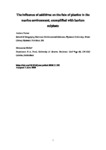The influence of additives on the fate of plastics in the marine environment, exemplified with barium sulphate
| dc.contributor.author | Turner, Andrew | |
| dc.contributor.author | Filella, M | |
| dc.date.accessioned | 2020-07-09T11:58:40Z | |
| dc.date.issued | 2020-09 | |
| dc.identifier.issn | 0025-326X | |
| dc.identifier.issn | 1879-3363 | |
| dc.identifier.other | 111352 | |
| dc.identifier.uri | http://hdl.handle.net/10026.1/15930 | |
| dc.description.abstract |
With an inherent density marginally below that of seawater, polyolefins (polyethylene-polypropylene) are predicted to float or undergo beaching in the marine environment. Polyolefins commonly observed on the seabed, therefore, require additional considerations that are usually based around increasing density through fouling or packaging into sinking faecal matter. Here, however, we propose that the presence of additives is of least equal significance to the behaviour of such plastics in marine systems. We compared barium, present largely as the filler, BaSO4 (density = 4.5 g cm-3), in consumer and beached plastics and established that the metal was more abundant and occurred at higher concentrations in the former samples, consistent with the environmental fractionation of plastics based on additive content. Significantly, the Ba content of polyolefins required to confer a density above seawater is about 13,000 mg kg-1, a value that was exceeded in many consumer plastics but never observed in beached samples. | |
| dc.format.extent | 111352-111352 | |
| dc.format.medium | Print-Electronic | |
| dc.language | en | |
| dc.language.iso | en | |
| dc.publisher | Elsevier BV | |
| dc.subject | Marine plastics | |
| dc.subject | Additives | |
| dc.subject | Barium | |
| dc.subject | XRF | |
| dc.subject | Density | |
| dc.subject | Fractionation | |
| dc.title | The influence of additives on the fate of plastics in the marine environment, exemplified with barium sulphate | |
| dc.type | journal-article | |
| dc.type | Journal Article | |
| plymouth.author-url | https://www.webofscience.com/api/gateway?GWVersion=2&SrcApp=PARTNER_APP&SrcAuth=LinksAMR&KeyUT=WOS:000555500000008&DestLinkType=FullRecord&DestApp=ALL_WOS&UsrCustomerID=11bb513d99f797142bcfeffcc58ea008 | |
| plymouth.volume | 158 | |
| plymouth.publication-status | Published | |
| plymouth.journal | Marine Pollution Bulletin | |
| dc.identifier.doi | 10.1016/j.marpolbul.2020.111352 | |
| plymouth.organisational-group | /Plymouth | |
| plymouth.organisational-group | /Plymouth/Faculty of Science and Engineering | |
| plymouth.organisational-group | /Plymouth/Faculty of Science and Engineering/School of Geography, Earth and Environmental Sciences | |
| plymouth.organisational-group | /Plymouth/REF 2021 Researchers by UoA | |
| plymouth.organisational-group | /Plymouth/REF 2021 Researchers by UoA/UoA07 Earth Systems and Environmental Sciences | |
| plymouth.organisational-group | /Plymouth/Research Groups | |
| plymouth.organisational-group | /Plymouth/Research Groups/BEACh | |
| plymouth.organisational-group | /Plymouth/Research Groups/Marine Institute | |
| plymouth.organisational-group | /Plymouth/Users by role | |
| plymouth.organisational-group | /Plymouth/Users by role/Academics | |
| dc.publisher.place | England | |
| dcterms.dateAccepted | 2020-06-03 | |
| dc.rights.embargodate | 2020-7-11 | |
| dc.identifier.eissn | 1879-3363 | |
| dc.rights.embargoperiod | Not known | |
| rioxxterms.versionofrecord | 10.1016/j.marpolbul.2020.111352 | |
| rioxxterms.licenseref.uri | http://www.rioxx.net/licenses/all-rights-reserved | |
| rioxxterms.licenseref.startdate | 2020-09 | |
| rioxxterms.type | Journal Article/Review |


